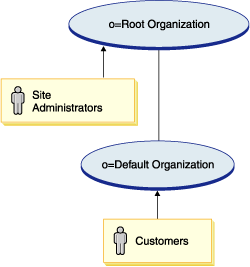Organization structure
The HCL Commerce organization structure provides a framework for the actors, or entities, in your business scenario. This framework is organized in a hierarchical structure, which mimics typical organizational hierarchies with entries for organizations and organizational units and users. The organizations and organizational units in the framework act as owners for the parts of your business. All parts of your business, including customers, administrators, stores, catalogs and distributors, must be owned by an organization or organizational unit.
The organization structure and the access control model, are closely related, in that the access control model applies access control policies to organizations rather than to individual entities (stores, customers, administrators, and more). The policies that apply to an entity (or resource) are applied to the organizations that own the entity or resource.
The MemberRegistrationAttributes.xml file is used to dynamically assign HCL Commerce roles to authenticated users. This dynamic assignment occurs during logon, registration, and single sign-on to HCL Commerce. By default the file handles assigning roles for many common organization structures. Ensure that the file is configured to meet your business requirements. For more information about this file, see MemberRegistrationAttributes XML and DTD files.
The following diagram outlines the basic HCL Commerce organization structure. The basic organization structure is installed during instance creation, regardless of the business model.

- Root organization
- The root organization is the top-level organization and is its own parent. All organizations in the HCL Commerce organization structure are descendants of the root organization. The site administrators are owned by the root organization.
- Default organization
- The default organization is owned by the root organization. All guest customers and all
customers in a B2C scenario belong to the default organization. Customers in a B2B or B2B
indirect scenarios should not be placed under the default organization, but rather in the
appropriate buyer organization. B2C users under the default organization can be managed by an
administrator in HCL Commerce Accelerator. Business users outside of the default
organization can be managed in the Organization Administration Console. Do no create stores under
the default organization. Instead, create stores under a separate organization, such as the seller
organization.Note the following considerations about the Default Organization:
- OrgAdminConsole: This tool to manage business users and administrators does not list users under the Org -2000 (Default Org), or allow users to be created under the Default Org, since it assumes that is where B2C Shoppers (and guest users) are kept. Accelerator can be used to manage B2C shoppers.
- Access Control: By default, Default Org (-2000) subscribes to GuestShopperManagementPolicyGroup which allows for some administrators (regardless of where they play their role) to manage the users under the Default Org. Guest users are implicitly owned by the Default Organization (-2000), when an access control check is done on this type of user, since guest users do not exist in the MBRREL table.
- MemberRegistrationAttributes.xml: By default, it has configurations that assume the Default Org DN.
- UserRegistrationAdd command: If no parentMember is specified (for example, the B2C scenario), the user will be placed under the Default Org.
One or more other levels of organizational entities can exist beneath the parent organizational entities. You can add as many child organizational entities as necessary to support your business.
Sample organization structures
HCL Commerce provides sample organizations structures for each supported business model. These sample organization structures are available on their own as component store archives. You can use these sample organization structures as starting point for your own site, or as part of the sample businesses.
Creating organization structures
Rather than create new organization structures for your site, it is recommended that you begin by publishing one of the sample organization structures that are provided with HCL Commerce. Then, modify that organization structure as necessary.
| Organization structure | Method of creation |
|---|---|
| All organization structures | Root organization and Default organization that is created by instance creation |
| B2C organization structure |
|
| B2B organization structure |
|
| Extended sites organization structure |
|
The HCL Commerce organization structure is flexible enough to support all entities in the supported business models.